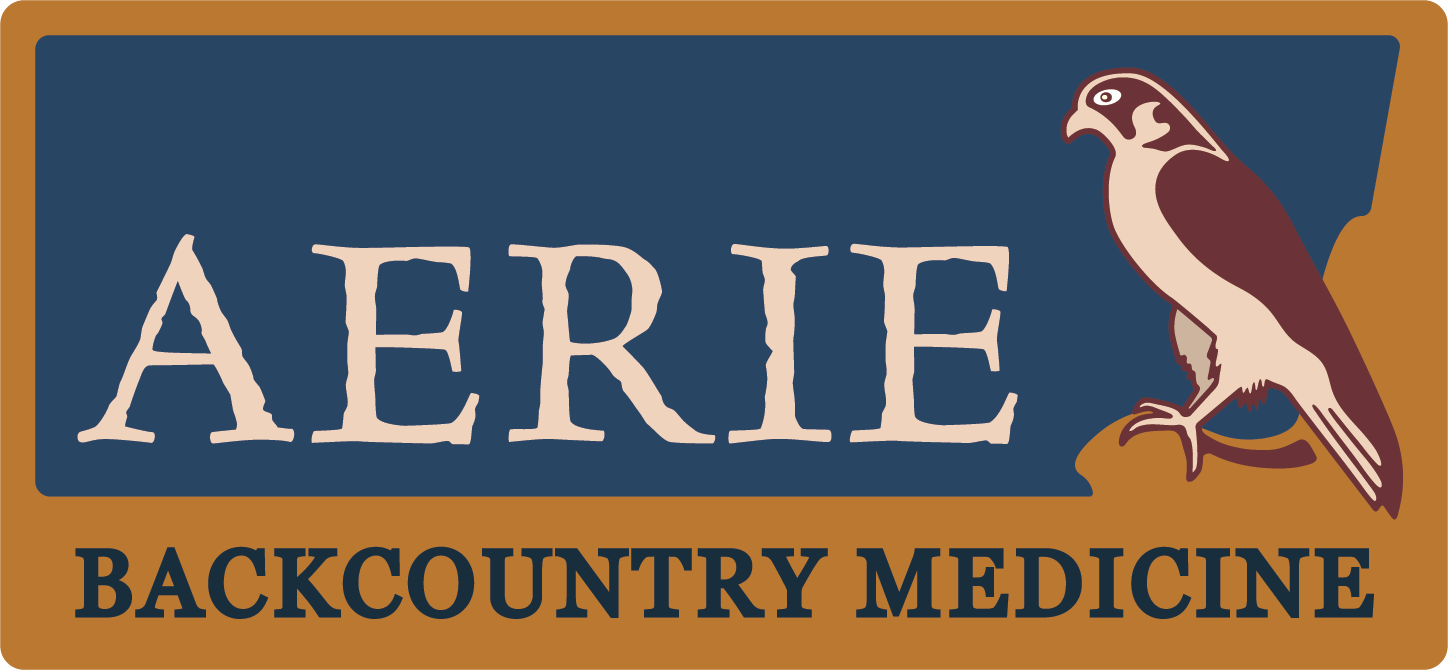Fall Semester
Overview
Aerie Backcountry Medicine’s Fall Semester Program provides unparalleled opportunities to learn and practice wilderness medicine and rescue skills in Montana and India all while earning 15 upper division credits through the University of Montana.
Our Fall Semester begins at the beautiful Jack Creek Preserve located near Big Sky where students live, study, and certify as Emergency Medical Technicians. You’ll be studying and working hard during this section to prepare for the Psychomotor and Cognitive Exam. Partway through this section, we will take a long weekend and travel to the Buffalo Field Campaign located in West Yellowstone to enjoy several days of camping, hiking, and work on Land Navigation components needed for your travel through the Himalaya the following month. Our time in Big Sky Country will be nearing completion as you pass your final exams and progress to the next phase of this exciting Fall Term.
Students then head back to Missoula to complete line qualification for Wildland Fire Operations with Aerie’s professional wildlands firefighting instructors. You will examine the structure of command and develop skills needed to be operationally ready as a care provider on the fire line. Swing a tool, deploy a shelter, and pass the arduous pack test. Remember you’ll be carrying a big pack at high elevation in the weeks to come so think of this as part of your ongoing physical training.
Our Montana section ends on a high note with the Whitewater Rescue Institute in Alberton where students engage in high angle ropes rescue training. You will learn the fundamentals of rescue rigging and be capable of accessing terrain that only the most skilled practitioners can. Build anchors, belay rescuers, and use mechanical advantage. During this section you will gain endorsement as a UTV driver, this skill is paramount for care providers on a Rapid Extraction Module Support Team (REMS) during fire line operations.
Take a week to visit family and friends, pass your NREMT cognitive exam, and pack for a month in the Himalaya.
Students and instructors travel to the Hanifl Centre located in the Indian Himalaya to trek high in the mountains while focusing on outdoor leadership. This leg of the journey will put all of your new found skills to the test as we travel high in the mountains for 12 days. You will pack in your own food, fuel, and gear to sustain this trek. You will be working towards a Wilderness EMT certification while becoming a Leave No Trace Trainer all while leading your cohort through the rugged terrain of the greatest mountain range on earth.
Return from the high mountains to complete the program while working alongside Indian doctors, nurses, and paramedics in the hospital setting. We will travel to remote villages or busy hospitals to learn in the clinical setting. If you are ready to set out on the semester of a lifetime, then please contact David Kerner – Semesters Program Coordinator at david@aeriemed.com or call our office at (406)542-9972.
Jump to these sections for more information:

Credits & Certifications
- 15 upper-division University of Montana credits
- Aerie Wilderness Emergency Medical Technician (W-EMT) certification
- National Registry EMT (EMT) certification
- State of Montana EMT certification (optional)
- American Heart Association BLS CPR certification
- Red Card Wildland Firefighting certification
- Ropes Rescue Technician (REMS+UTV) certification
- Leave No Trace Trainer certification
*Earning credits and certifications is dependent on successful completion of required physical and practical examinations as well as final payment of tuition.
For more information on the certifications, including recertification requirements, please read through the FAQ tab.
University credits consist of three separate 5-credit upper-division courses from the University of Montana: Emergency Medical Technician and Incident Management; Wilderness Medicine and Risk Management; and Wilderness Rescue and Survival Skills. Our students receive official transcripts from the University of Montana for Semester coursework.
To transfer credits to your university, you will need to get approval from your advisor and possibly your university’s registrar. Most schools allow transfer of credits from other degree-granting institutions. Assuming your university will accept transfer credits from UM, your advisor will need to make a determination about HOW the credits will transfer to your degree. They may come in as upper-division electives, or your advisor may agree to use them towards a specific degree requirement. Please email david@aeriemed.com for more information, and feel free to forward the syllabi above to your advisor for review.
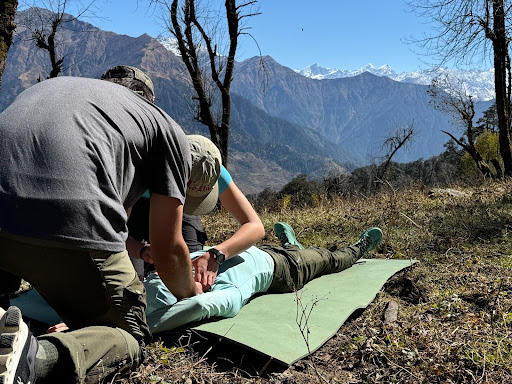
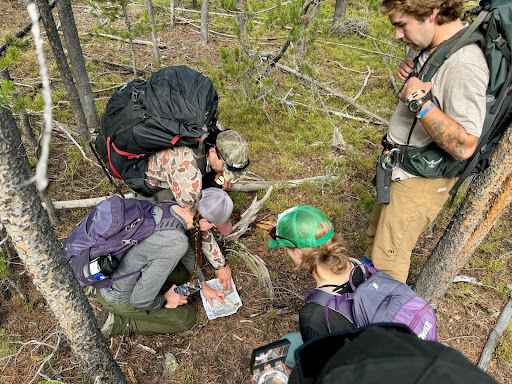


Locations
Check out the list of amazing host facilities here:
- Shady Spruce Hostel, Missoula, MT
- Jack Creek Preserve, Big Sky, MT
- Buffalo Field Campaign, West Yellowstone, MT
- Whitewater Rescue Institute, Alberton, MT
- Hanifl Centre, Mussoorie, India
- Landour Community Hospital, Mussoorie, India
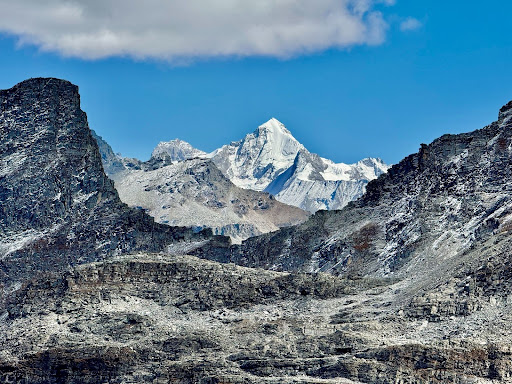
Dates
August 31st – November 9th, 2025
08/31-09/02: Course orientation in Missoula
09/03-09/22: EMT training at Jack Creek Preserve
09/23-09/25: Red Card in Missoula
09/25-10/1: REMS Training in Alberton
10/9-11/9: Travel to India
Please note that the program ends in Delhi, India on 11/08/2025. You are free to continue traveling or return directly home. Any travel arrangements after 11/08 need to be planned independently of the Aerie program and may require different visas.
We have tweaked a couple things in an effort to reduce travel costs and simplify travel for some participants. The program will begin in Missoula, and that is the last stop before India as well. We will travel to Bozeman but you only have to worry about two airports: Missoula (MSO) and Delhi (DEL).
We have built in a 7 day recess between the Montana and India portions. Aerie will not provide food and lodging during this time, you are on your own to get prepared for the international section.
The recess allows for students to travel home and depart from India there if they would like. I am trying to give as much flexibility as possible for itineraries. Whatever itinerary you choose, it is strongly recommended to arrive on United Airlines flight 82, landing in Delhi at 21:20 on 10/10/2024. Aerie staff will be on that flight and it will make pick-up and hotel shuttles easiest to have students on UA 82 as well. I have included an example itinerary below that would be efficient and arrive on the proper flight.
Missoula – Delhi on United Airlines
06:15 MSO – DEN on UA 2045
13:25 DEN – EWR on UA 1505
21:20 EWR – DEL on UA 82
Arrives 21:30 on 10/10/2025
Delhi to Missoula on United
23:55 DEL-EWR on UA 83
12:30 EWR-DEN on UA1254
19:18 DEN – MSO on UA 1092
Arrives 21:26 on 11/09/2025
Here are the important travel dates:
Arrival in Missoula (MSO): 09/01/2025 – just a check-in day, no classwork
Program recess begins: 10/02/2025 – no class work until India
Departure for Delhi, India (DEL): 10/09/2025 – that will have you arriving on 10/10/2025 after the time change.
Return from Delhi, India (DEL): 11/08/2025
Costs
$19,900 program cost includes the following:
- The following certifications:
- EMT and Wilderness EMT
- American Heart Association BLS CPR
- Red Card Wildlands Firefighting Certification
- Rope Rescue Technician Certification
- Leave No Trace Trainer Certification
- Course texts ($125):
- Aerie Wilderness Medicine
- Rope Rescue
- Leave No Trace
- AMC Guide to Outdoor Leadership
The following items are NOT included with tuition:
- Registration fee for 15 upper division credits from the University of Montana (optional – approximately $465)
- EMT text book (approximately $120)
- National Registry of EMT on-line registration and computer testing fee (approximately $100)
- State of Montana EMT licensure (optional – approximately $50)
- Any costs associated with early departures or personal medical emergencies – including shuttles to and from medical care.
- Airfare to and from Delhi, India airport code DEL
Scholarships/ discounts
Please contact our Semester Coordinator, David Kerner, if you are eligible for any of the following:
- Early-Bird Registration
- $3,000 tuition discount for any student paying their non-refundable $5,000 deposit 6 months or more before the start of the program.
- Students may be eligible for no more than one of the following tuition discounts:
- AmeriCorps members/alumni using their AmeriCorps awards will have their awards matched, up to $3,000 or
- AmeriCorps members/alumni without education awards – $3,000 tuition discount or
- Alumni or staff of the following: Student Conservation Association, American Conservation Experience, and any other state Conservation Corps or Youth Corps programs – $3,000 tuition discount or
- Montana-state residents or students enrolled at a Montana college – $3,000 tuition discount
- Deposits are required to secure a student’s enrollment in the Semesters in Wilderness Medicine. These deposits are non-refundable and non-transferable.
Students may also be able to use the following:
Federal Financial Aid (FAFSA)
Because Aerie’s Spring Semester program is offered through the University of Montana, students who are currently receiving federal financial aid using the FAFSA are often able to use their financial aid to pay for the Semester tuition. Aerie can help facilitate this process. The process for doing this is described here. Contact Semester Coordinator, David Kerner, with any questions.
AmeriCorps Awards
Because the program is run through an accredited Title IV university, AmeriCorps members and alumni can use their Segal Education Awards to pay for their tuition. If you have completed more than one AmeriCorps program, you are able to use all your awards, cumulatively, for tuition. The process for doing this is described here. Contact Semester Coordinator, David Kerner, with any questions.
Clinical Experience
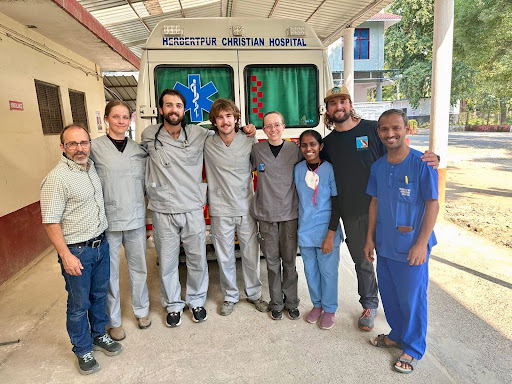
Aerie’s Semesters are, above all else, about the medicine. Our students complete their education and training with more clinical experience and practice than you can get anywhere. We believe excellent patient assessment and care are at the heart of all other advanced skills. Aerie Semesters not only offer extensive practice for EMT skills, leading to universally high rates of National Registry certification, but we also provide actual patient assessment experience in professional settings.
Fall SWM FAQ
Will I have time off during the program for personal travel or recreation?
Very little. You should plan to come to the program early or stay afterwards for personal recreational travel of more than a day.
Will there be tests and homework?
Yes. Homework is assigned each night and initially may include up to 100 pages of reading per night. At least two written exams are given each week in addition to a weekly practical exam.
What does the “online coursework” consist of?
Because of the heavy reading load in the National Registry EMT text, we assign 9 chapters of reading and associated online quizzes during the month preceding the start of the Semester. Students can complete this work wherever they happen to be, as long as they have internet access to submit their quiz answers.
What are Aerie’s academic expectations?
High. Aerie’s course policies outline our academic expectations; you will be given a handbook outlining our course policies once you have been accepted into the Semester. Students must receive passing grades on weekly exams to be eligible to test for the National Registry final exam; this is not an Aerie policy – it is a National Registry policy. Poor grades may result in expulsion from the program and may result in not being able to test for, or receive, your National Registry EMT certification.
What are the travel requirements and responsibilities of each student?
Travel to and from our international locations is the student’s responsibility. Airfare is not included in your course tuition. Additionally, students must have a valid passport with an expiration date that is at least 6 months after the program’s end date. All passport information must be accurate and consistent with the information on your other forms of identification. Students are highly encouraged to visit the CDC Yellowbook website and consult their healthcare provider before traveling abroad.
What are the physical requirements for the program?
All Aerie Semesters are physically challenging. You will carry 30-60 lb backpacks 6-10 miles per day during certain sections of the program. During these days, you can expect to climb 2,000-3,000 vertical feet and to live at elevations of 3,000-9,000 feet above sea level (sometimes at 15,000 feet for the Fall India section). With your team, you will carry litters and gear across uneven terrain and rivers, and will be expected to swim and climb. You will work outdoors in snow, rain and ice and will be expected to maintain a positive learning attitude regardless of the weather or activity. Great athletic, climbing or swimming experience are not necessary to successfully complete the program; however, all of these activities require physical conditioning conducive to constant movement in these environments. Please contact us if you have any concerns.
Do I need to be enrolled in college to participate in the Semester?
No, participants do not need to be university students to enroll. However, they may need to be enrolled to receive federal financial aid and university sponsored health insurance.
How long do the certifications last, who issues them, what are their recertification requirements, and what types of jobs and/or further opportunities can I get with the experiences and certifications the Semester offers?
The certifications and experiences the Semester offers are unique, professional-level, and rewarding, designed specifically for the highly competitive professional outdoor and medical/ nursing/ PA ambitions of our students. The following list shows where our students use their certifications, but please remember that there are no guarantees that any organization or school is going to hire or admit you based on a certification or transcript.
- Aerie Wilderness Emergency Medical Technician (WEMT) certification: Aerie WEMT certifications last for two years. To recertify, WEMTs also need to recertify their urban EMT (see next bullet) and complete 8 additional hours of wilderness-specific training. For jobs, the National Park Service, US Forest Service, many guiding and outdoor organizations such as NOLS, Outward Bound and the Student Conservation Association look for Wilderness EMTs to lead their backcountry crews. Wilderness EMTs must be current urban/ state/ National Registry EMTs to keep their “wilderness” certifications.
- National Registry EMT (NREMT) certification. NREMT certifications are valid for two years. To recertify, NREMTs must complete 48 hours of continuing education, a 24 hour EMT refresher, and have six months affiliation with an agency providing EMT-level care. These requirements are listed here. This is the standard certification for working on an ambulance or in an Emergency Room as a Technician in many parts of the US. If you are looking to see what your home state requires for EMT licensure/ certification, click here. Many ambulances around the US require EMTs to be 21 years old to drive the ambulance.
- State of Montana EMT certification, offered through the Montana Board of Medical Examiners. Montana EMTs must recertify every two years, complete 48 hours of continuing education, a 24 hour EMT refresher class, and have 6 months affiliation with an agency providing EMT-level care. You do not need your Montana EMT certification if you are not planning on working in MT as an EMT. This is the certification you will need if you want to work as an EMT in the state of Montana.
- American Heart Association Healthcare Provider CPR certification. This certification lasts for two years and is recertified by taking a 2-8 hour refresher course. This is the highest level of CPR certification, is required for EMTs, and can be used for any job requiring CPR certification.
- Swiftwater Rescue Technician (SR-Technician) certification, offered by the Whitewater Rescue Institute. SRT certification lasts three years and is recertified by taking another course. This certification is often required for raft and/ or river guides.
- Leave No Trace certification is offered through LNT.org and is taught by Aerie instructors who are also LNT Master Trainers. It is recertified by taking another LNT course. This certification is viewed by employing agencies as a standard for outdoor leaders and educators.
The wildlands firefighting certifications are offered through Aerie, the National Wildfire Coordinating Group (NWCG), and the Federal Emergency Management Agency (FEMA). They vary in duration of certification. For more information about Aerie’s firefighting training, visit our Wildland Fire page
Are there any prerequisites for the Semester?
Students must be ready for an intense, challenging experience, but there are no specific academic prerequisites. Many of our best students have had no previous medical training. Students are not required to be 18 years of age, but Aerie Management will admit younger students on a case by case basis. In addition, to test for and receive National Registry EMT certification, students must have a high school diploma/ GED and have no current felony convictions. Otherwise, we expect students to arrive with a solid work ethic, open mind and positive attitude.
What are the refund policies for the Semester?
No refunds are given for any reason, including sickness, family emergencies, or expulsion from the program. For this reason, we strongly encourage all participants to have trip and health insurance to cover the possibility of their not completing the program. In the event that a student leaves the program early, whether voluntarily or at Aerie’s discretion, all expenses associated with their departure from the program, including airfare, travel to and from field sites to airports/ bus facilities, and health costs, are solely the student’s responsibility. If, for example, a student is injured or becomes ill and they are unable to complete some or all of the program, they will be responsible for their own food, housing and any other costs associated with their recovery.
Is this program safe?
Our Semester programs have inherent risk. Aerie believes that students learn best when they are involved in realistic, engaging scenarios and practical sessions. As a result we simulate these environments in our classroom scenarios and head out into the field to swim, hike, snowshoe, ski, carry heavy packs and cross difficult terrain depending on the season and location. In addition, the international components of the Semester have their own unique risks, including significant distance from advanced medical care as well as potential exposure to illness during clinical rotations. The risks we face during these exercises are similar to those faced in an austere, remote environment. We encourage you to talk with our staff about risks inherent in our training programs before enrolling. Depending on course location, injuries and illnesses that occur may require prolonged evacuations and may necessitate repatriation to the United States.
Please do not register for any Aerie course, particularly our Semesters, without exploring, understanding and accepting these risks.
